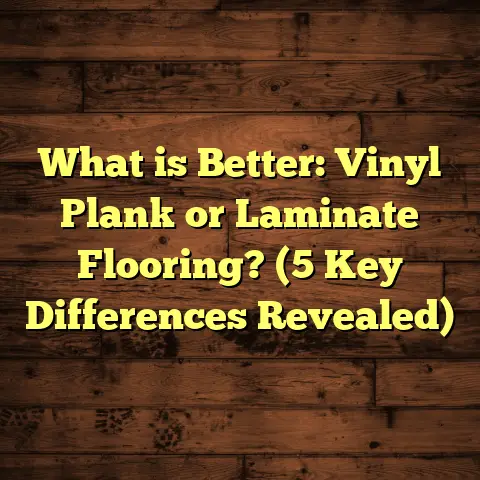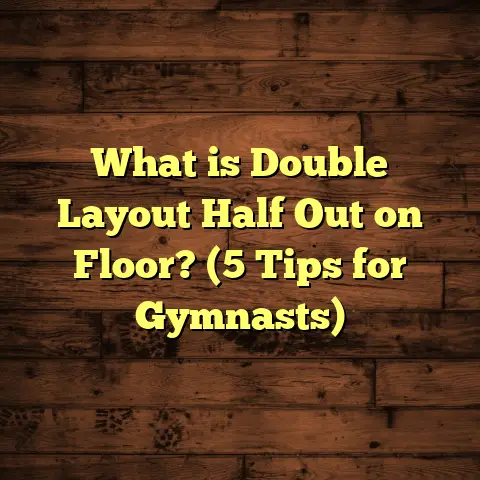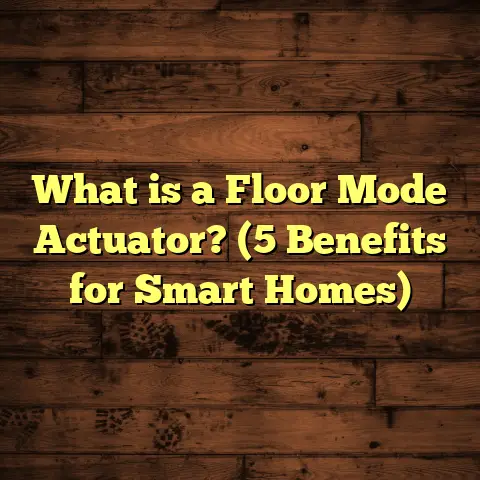What is a Finished Floor Footprint? (5 Key Design Insights)
What if you were about to start a flooring project and thought you had everything figured out, only to realize halfway through that the materials you ordered won’t cover the entire space? Or worse, that you’ve bought way too much and ended up wasting money and precious resources? I’ve been there more times than I care to admit, especially in my early days as a flooring contractor. One project in particular sticks out—the kind of project that forever changed how I approach measuring and planning flooring installations. It was a charming 1920s bungalow with quirky room shapes and loads of built-in nooks. We had ordered materials based on rough room dimensions, but once we peeled back the layers and started measuring for the finished floor, the true complexity revealed itself. The finished floor footprint was much larger than expected, with many tricky cuts around doorways, radiators, and cabinetry. We had underestimated waste and didn’t account for transitions properly. The result? Delays, extra costs, and a lot of stress.
That experience taught me something crucial: the finished floor footprint is the foundation of a successful flooring project. It’s not just a number; it’s a detailed understanding of how your floor will actually be laid out—how much material you need, how much waste to expect, how design choices affect the final coverage, and how to budget realistically.
If you’re thinking about new floors or renovating your space, understanding this concept can save you money, time, and headaches. Let me walk you through everything I’ve learned over the years so you can approach your next project with confidence.
What Is a Finished Floor Footprint?
The finished floor footprint is the actual surface area covered by your flooring material once it’s installed. It’s measured in square feet or square meters but goes beyond just multiplying room length by width. It includes every detail where flooring will be placed—from under kitchen islands to areas around built-in furniture, cutouts for vents, and even the tiny slivers between walls and door casings.
Think of it like this: If you laid out your chosen flooring material flat on the floor before installation, the footprint is the exact shape and size of that layout.
Why Is This Different from Room Square Footage?
The room’s square footage is a simple measure of length times width, assuming perfectly straight walls and no interruptions. The finished floor footprint takes into account:
- Irregular shapes: Many rooms aren’t perfect rectangles; they have alcoves, bay windows, or rounded corners.
- Transitions: Where one flooring meets another (hardwood to tile, carpet to vinyl), extra material may be needed for transition strips.
- Waste: Flooring materials require cutting to fit corners and edges; this results in leftover pieces.
- Cutouts: Areas for vents, pipes, or cabinets where flooring must be cut precisely.
In practice, the finished floor footprint can be 5-20% larger than the simple room square footage.
How Do You Measure It?
Measuring the finished floor footprint involves detailed steps:
- Draw or obtain a floor plan: Start with an accurate plan showing all wall lengths.
- Measure every wall segment: Include any recesses or protrusions.
- Account for obstacles: Mark areas with cabinets, fireplaces, vents, or doorways.
- Calculate irregular shapes: Use geometric formulas or software to find areas of triangles, circles, or trapezoids.
- Add waste factor: Depending on material and layout complexity.
I recommend using laser measuring tools or apps designed for flooring professionals to get precise data. When I first started using these tools years ago, my estimates became far more reliable.
1. The Shape of Your Space Changes Everything
Ever notice how a rectangular room feels simpler than an L-shaped or multi-cornered space? This isn’t just about aesthetics—the shape affects your flooring materials and installation process heavily.
Why Do Irregular Shapes Increase Footprint Size?
Irregular rooms have more edges to cover, so you’ll inevitably make more cuts. Each cut wastes some material because offcuts might not be reusable elsewhere. Also, fitting flooring around curves or odd corners requires custom shaping that adds to waste.
For example:
- A perfectly square 12’x12’ room is 144 sq ft flat.
- An L-shaped room made of two rectangles (8’x12’ + 4’x8’) totals 128 sq ft theoretically.
- But when adding cutouts around doorframes or built-ins and factoring waste, your finished floor footprint might jump to around 140-150 sq ft.
I worked on a home with polygonal-shaped rooms where we had to calculate dozens of small sections separately. The project’s material order was off by almost 18% initially because we didn’t anticipate the complexity.
How Does Shape Influence Installation?
More edges mean more seams and joints between flooring planks or tiles. These joints require careful alignment and sometimes special transition strips that add cost and labor time.
Pro tip: Break down complex rooms into smaller shapes when measuring. This makes calculations manageable and reduces errors.
2. Waste Factor: More Than Just Extra Pieces
Every flooring project generates waste—scraps left over after cutting planks or tiles to fit walls and obstacles. But waste isn’t just about scrap pieces; it also accounts for mistakes during installation and pattern matching requirements for certain tiles or wood grains.
Typical Waste Percentages by Flooring Type
| Flooring Material | Waste Percentage Range |
|---|---|
| Hardwood | 5% – 10% |
| Tile | 10% – 15% |
| Vinyl | 3% – 5% |
| Carpet | 5% – 7% |
For hardwood floors with straight grain patterns, waste tends to be lower because cuts are simpler to plan. But if you’re installing hand-scraped or distressed hardwood that requires pattern matching, waste rises due to selective plank placement.
Tile waste increases with complex shapes or odd-sized rooms because tiles break easily during cutting and handling.
When I worked on a large commercial tile floor installation, we tracked waste carefully over several phases. Our average tile waste was closer to 16%, higher than typical estimates but justified by complex patterns and onsite adjustments.
How To Minimize Waste
- Plan layouts carefully before ordering materials.
- Buy from reputable suppliers who allow returns on unused full boxes.
- Use leftover pieces creatively in closets or less visible areas.
- Work with experienced installers who minimize mistakes.
Waste is inevitable but manageable with good planning.
3. Transitions Affect Your Footprint Too
Transition areas occur where two different flooring types meet—think hardwood flowing into tile in a kitchen or carpet meeting vinyl in a hallway. These junctions might seem minor but have significant effects on your finished floor footprint.
Why Transitions Add to Material Needs
Transitions often require:
- Special strips or molding pieces.
- Slight overlaps between materials.
- Additional trimming of flooring planks or tiles.
For example, when hardwood meets tile, you may need a metal or wood transition strip that covers an inch or two of each surface. This means ordering extra hardwood planks beyond what the main room area requires.
I recall a project where transitions were overlooked during measurement. When installation reached those junctions, we realized an extra 10 linear feet of strips were needed along with additional material for overlap cuts. This added nearly $600 in unexpected costs.
Planning for Transitions
Include transition areas in your floor footprint measurement by:
- Mapping doorways or passage points where floors change.
- Estimating linear feet needed for strips.
- Adding extra material for overlaps beyond simple room dimensions.
4. Subfloor Conditions Impact Installation Area
Sometimes your finished floor footprint isn’t just about horizontal surface measurements—it’s also affected by what lies underneath: the subfloor.
How Subfloor Issues Change Your Footprint
Uneven or damaged subfloors may require:
- Adding leveling compounds.
- Installing plywood layers.
- Adjusting floor height around edges.
These adjustments can slightly increase the total installation area due to trimming baseboards or modifying thresholds.
In one renovation I managed, water damage under a living room floor required replacing subfloor panels. The repair area extended beyond original room boundaries because adjacent sections had minor damage too. This increased our material order by about 7%.
Why Subfloor Condition Matters
Ignoring subfloor problems can cause:
- Poorly installed floors that warp or squeak.
- Increased costs from last-minute repairs.
- Installation delays affecting your entire schedule.
When measuring your finished floor footprint, inspect the subfloor carefully or hire professionals to assess it beforehand.
5. Flooring Type Influences Footprint Calculation
Each flooring material comes with its own quirks affecting how you measure and order materials for your finished floor footprint.
Hardwood Floors
Solid hardwood requires expansion gaps (usually about 3/8 inch) around walls to allow for natural movement caused by humidity changes. These gaps mean you won’t install planks edge-to-edge with walls; some trimming will occur after installation.
Also, hardwood planks come in varying widths and lengths—some projects mix plank sizes for style—which influences layout complexity and waste factor.
Engineered Wood
Engineered wood behaves similarly but can be installed tighter because it’s more stable against moisture changes.
Tiles
Tile installation includes grout joints which add small spaces between tiles—usually from 1/8 inch to 1/4 inch wide—slightly increasing total coverage area compared to tile surface measurements alone.
Mosaic or patterned tiles require even more precise measurement because matching patterns often cause higher waste percentages.
Vinyl & Laminate
Vinyl sheets sometimes come in rolls wider than room widths; installers cut them carefully to fit but usually have less waste than wood or tile. Laminate planks click together tightly but still need expansion gaps at edges.
Carpet
Carpet rolls often come in fixed widths (12 feet commonly), so rooms wider than that require seaming which adds complexity but doesn’t usually increase surface area needed drastically beyond room size plus waste for trimming.
My Journey With Finished Floor Footprints: Lessons Learned
When I started as a novice contractor years ago, I used rough estimates based on room dimensions alone—big mistake! I recall one job where we ordered hardwood for a 1,200 sq ft house based on simple length x width calculations. Installation revealed numerous corners, angled walls, closets with strange shapes, and staircases that weren’t accounted for properly. We wasted around $1,500 worth of wood due to unforeseen cuts and adjustments.
Since then, I started investing in better measuring tools—laser distance meters and digital plans—and began educating clients about the importance of understanding their true finished floor footprint before ordering anything.
On another project—a modern condo with open-plan living spaces—I worked closely with the architect to get detailed CAD drawings of every room’s shape. We included transitions between different flooring types like hardwood in living areas and tile in bathrooms along with baseboard details affecting expansion gaps. This level of detail saved nearly $2,000 in material costs by preventing over-ordering while ensuring enough coverage for tricky areas.
Data Insights: How Much Can Finished Floor Footprint Errors Cost You?
Let’s look at some real numbers from industry data combined with my own project records:
| Flooring Type | Average Cost per Sq Ft (Material + Labor) | Cost Impact of Underestimating by 10% (1000 sq ft) | Typical Waste % |
|---|---|---|---|
| Solid Hardwood | $8 – $12 | $800 – $1,200 | 5 – 10% |
| Tile | $10 – $20 | $1,000 – $2,000 | 10 – 15% |
| Vinyl | $4 – $7 | $300 – $700 | 3 – 5% |
| Carpet | $3 – $6 | $150 – $420 | 5 – 7% |
Even a small miscalculation can add hundreds or thousands of dollars in unexpected expenses due to needing last-minute material orders or paying for rush shipping.
How Technology Helps Measure Finished Floor Footprints Better
In recent years, technology has transformed how contractors measure floors:
Laser Distance Meters
These devices measure distances accurately within millimeters using laser beams. They allow quick mapping of walls and obstacles without dragging tape measures everywhere.
I use a laser meter daily—it has cut my measuring time by more than half compared to manual methods.
Floor Plan Apps
Apps like MagicPlan or RoomScan let you create digital layouts using smartphone cameras combined with laser measures. They calculate square footage instantly and can export files for contractors and designers.
These tools also help visualize transitions and irregular shapes clearly on screen before ordering materials.
Software for Waste & Material Estimates
Specialized software can incorporate waste factors automatically based on your chosen material type and layout complexity—saving calculation errors.
Real Case Study: Multi-Room Renovation With Complex Footprints
A client wanted to renovate their entire main floor of roughly 1,500 sq ft consisting of:
- Living room with bay window alcove
- Kitchen with island peninsula
- Hallway connecting multiple rooms
- Bathroom tiled floors adjoining hardwood living spaces
We approached measuring methodically:
- Detailed floor plans created using laser measures.
- Each room broken down into smaller geometric shapes.
- Transition zones measured separately.
- Waste factor estimated at 8% overall due to mixed materials (hardwood + tile).
- Subfloor inspected revealing minor leveling needed under kitchen island area.
The finished floor footprint ended up being about 1,620 sq ft—nearly 8% larger than raw room sizes suggested due to alcoves and transitions.
With this data:
- Materials were ordered precisely.
- Installation schedules matched labor needs perfectly.
- The client saved approximately $1,400 versus initial rough estimates.
This case reinforced how detailed footprint measurement leads directly to better budgets and smoother projects.
Tips I Share With Homeowners and Contractors
If you’re planning your own project or managing one as a contractor:
- Start measuring early—don’t wait until ordering stage.
- Use technology tools for accuracy but double-check manually if possible.
- Include every inch where flooring touches—from wall bases to under cabinets.
- Add appropriate waste factor based on material type and room shape.
- Don’t forget transitions—they add up quickly!
- Inspect subfloors before finalizing measurements.
- Consult professionals if unsure—they can save you money long-term.
Frequently Asked Questions About Finished Floor Footprints
How much extra material should I order beyond my footprint measurement?
Generally add between 5% (for simple vinyl) up to 15% (for complex tile layouts). If you’re new to flooring projects, err toward ordering slightly more rather than less—but don’t overdo it!
Can I calculate finished floor footprint myself?
Yes! With patience and good measuring tools you can map your space accurately using basic geometry (rectangles, triangles). For more complex homes consider professional help or digital tools.
How do transitions impact my final cost estimate?
Transitions may require special strips costing $3-$10 per linear foot plus extra labor time for installation—add these costs to your total budget early on.
What happens if I underestimate my finished floor footprint?
You risk running out of materials mid-project which causes delays waiting on new orders and possible price increases on rush materials—plus extra labor costs from stopping work unexpectedly.
Final Thoughts (Not That You Asked!)
The finished floor footprint isn’t just another number—it’s the blueprint that guides your entire flooring journey from design through installation. Take it seriously; measure carefully; plan thoroughly; involve experts if needed—and watch how smoothly your project runs compared to others who skip this step.
Trust me when I say this knowledge has saved me thousands across projects—and it will do the same for you if you apply it right from day one.
If you want me to walk you through measuring your specific space or selecting materials based on footprint insights, just ask! Floors are my passion—and helping people get them right is what I’m here for.





